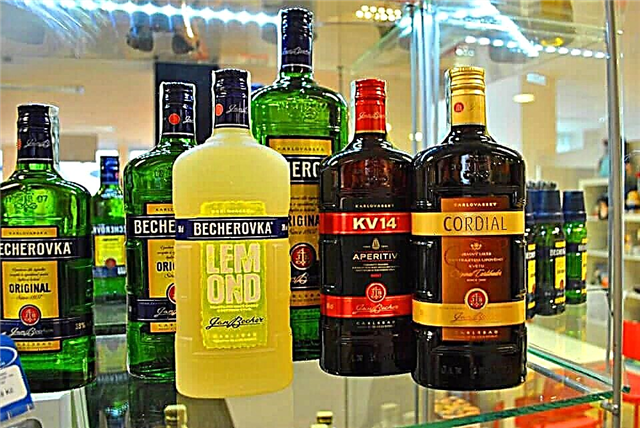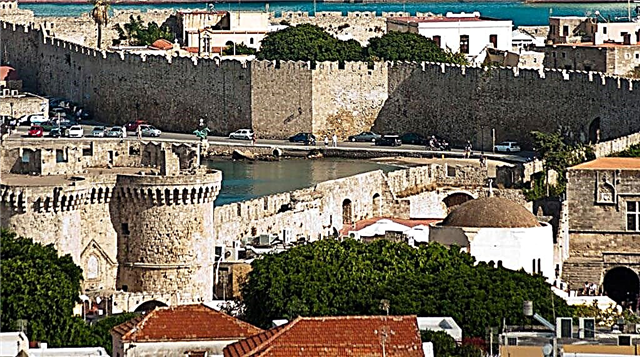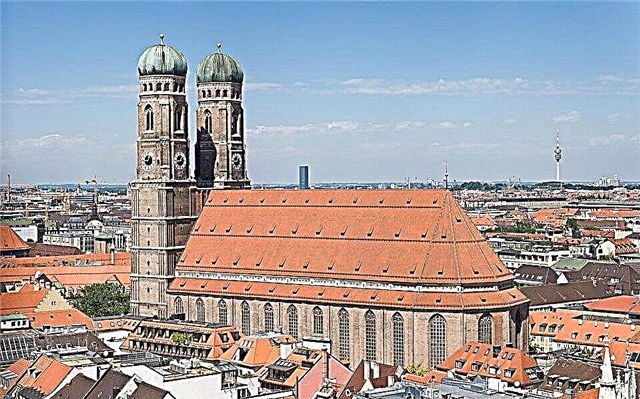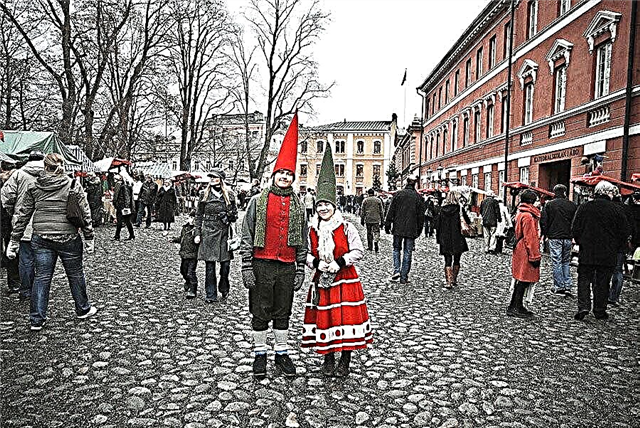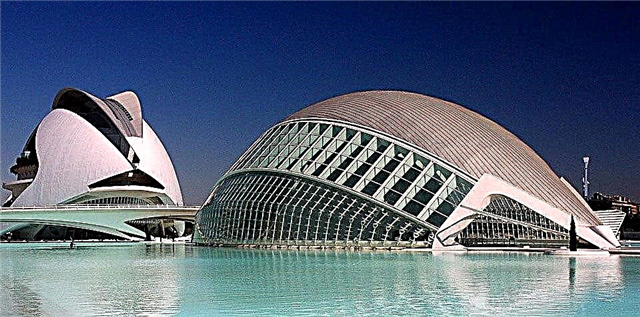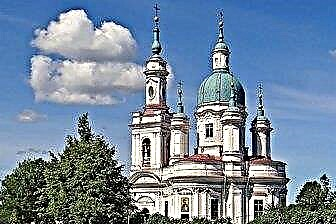Cordoba, combining the architecture and atmosphere of three cultures: Christian, Muslim, is called the priceless pearl of Andalusia. In its ancient history, pages were written by the Romans, the conquerors - the Moors, who turned the city into the unprecedented beauty of the capital of the Caliphate and who conquered it by the Spaniards. Walking along the ancient Roman bridge, erected under Julius Caesar, visiting luxurious palaces that have become museums, admiring the architecture of temples and looking at the shrines of three religions - is included in the program of millions of tourists visiting this colorful ancient. Seeing the sights of Cordoba and breathing in the atmosphere of the past centuries is like visiting three countries and the distant past at the same time. We invite you to take such an exciting journey.
Mesquite

Among the attractions of Spain, the Mesquita Cathedral is called the pearl, one of the 12 wonders of the country and listed as a UNESCO World Heritage Site. Mesquita stands on the sacred site of the former 11th-century Basilica of Saint Vincent. Then the Moors who conquered Andalusia erected a grandiose mosque instead of the Christian church.
Having conquered the city, the Spaniards rebuilt the building of the mosque into a Catholic Cathedral. Today the church appears in a harmonious interweaving of the Moorish style with the architecture of the Renaissance and late Gothic. Inside, the Mesquite is notable for the 856-column arches decorated with jasper, marble, granite and onyx. Next to the wall niche left from the mosque is the image of the Mother of God with Jesus.
The mahogany singing choirs admire images of scenes from the Old and New Testaments, the Virgin Mary and Christ and local saints. At the outer wall of Mesquita, there is a tower that was previously a minaret and is now crowned with a statue of the patron saint of the city, the Archangel Raphael. The cathedral is open for visits from 10.00 to 19.00. You can get there by bus number 3 or number 12, get off at the Puerta del Puente stop.
Roman bridge

The ancient Roman bridge, which connected the two banks of the Guadalaquir River in the distant 1st century, is an invaluable legacy left over from the Romans. It was not only of great importance for the city, but was part of the August road from Rome to Cadiz. In the XIV century, the Calahorra tower appeared on the southern side of the bridge, and 200 years later, a pompous structure of the entrance gate of Puerta del Puente, which became the entrance to the center of the Old City, arose in front of the tower.
The length of the Roman Bridge, resting on stone pillars separated by 16 arches, was 250 meters. The bridge is 7 meters wide. In the Middle Ages, in the dark, its parapets were illuminated by torches on both sides. Nowadays, they are replaced by forged lamps with frosted glass. In the 17th century, a marble column was erected in the middle of the bridge with a statue of the city's patron saint - the archangel Raphael at the top.
An amazing view of the Roman Bridge with the road leading to Puerta del Puente, appears from the Calahorra Tower. You can walk on the Roman Bridge around the clock and free of charge, see the gate from the inside - from Monday to Friday from 10.00 to 15.00. On weekends and holidays - from 11.00 to 15.00.
Column of the Archangel Raphael

The iconic landmark of the city is the 27-meter column of the holy Archangel Raphael. The grandiose building of the 17th century rises between the Roman Bridge and the Cathedral in Puerta del Puente. With this Column, the townspeople thanked the archangel for saving Cordoba from the plague. The symbolic meaning of the column can be seen in every part of it.
The rough relief of the high plinth symbolizes the underworld. The figures of a palm tree, an eagle and a horse are the personification of the river and the land of Cordoba. It is as if a 6-meter column grows out of the globe, surrounded by figures of three local holy martyrs - Atsikles of Cordoba, Victoria and Barbara. The building is crowned with a sculpture of the holy archangel Raphael, the heavenly patron overseeing the city.
Another 10 sculptures of the holy Archangel Raphael, made mainly of snow-white marble, can be found in city squares and streets, but the triumphal column in Puerta del Puente square cannot be confused with any other.
Calahorra Tower

One of the symbols of the city has long been the ancient three-story tower of Calahorra, which adorned the left bank of the Guadalakvira River. Built at the end of the Roman bridge in the 12th century by the Arabs, it served to watch and repel enemy attacks. Today the tower appears as a powerful fortification restored by the Spaniards in the XIV century, with light stone walls made of shell rock and a flat platform at the top, surrounded by battlements. Calahorra is somewhat dilapidated, but the roof still serves as a magnificent viewing platform for tourists.
Inside Calahorra, there are expositions of the Museum of Three Cultures, telling about the achievements of the inhabitants of Andalusia in different centuries. In the medical room it is interesting to look at the tools used by medieval doctors, comparing how far modern medicine has gone. Impress and familiarize yourself with the vast collection of musical instruments from different centuries. And at the end of the tour, get acquainted with the interior of the Andalusian house of the 10th century.
Open for visits: from October 1 to April 30 daily, from 10.00 to 18.00; from May 1 to September 30 from 10.00 to 14.00 and from 16.30 to 20.30 seven days a week.
Jewish Quarter of Huderia

From the walls of the cathedral mosque originates the most picturesque city quarter Juderia, inhabited by Jews from the 10th to the 15th centuries. The Huderia region has preserved the Moorish atmosphere of narrow streets with snow-white facades of houses, numerous flowers and cozy patios.
The territory of the quarter is bounded on the western side by the city wall with the Almodovar gate, on the southeast side - by the Alcazar wall. Juderia touches with graceful arches, thrown between the second floors through alleys, historical buildings, a series of located on both sides of the streets. The coziness of the old streets is given by many kosher restaurants, authentic and jewelry shops.
Tourists call the Zoco Municipal market one of the colorful attractions of Juderia, attracting numerous crafts and leather goods. The synagogue on the Calle de lo c-Judios, surprisingly untouched by the medieval inquisition and retaining its original appearance, has become a visiting card of the quarter. You can get to the Jewish Quarter by bus # 3 and # 12 to the Doctor Fleming stop.
Synagogue

The synagogue, built in 1315, is called the heart of the Jewish Quarter. When the Jews began to be expelled from Spain at the beginning of the 15th century, the synagogue became an infirmary, later the chapel of St. Crispin, and then a school. In the first half of the 20th century, the renovated building of the Jewish church was recognized as a national cultural monument.
Its façade amazes with sophisticated Mudejar ornamentation combining six-pointed stars with picturesque plant motifs. The walls of the male prayer hall admire the graceful national ornament. In the niche for the storage of the Torah, facing Jerusalem, the number 1315 is carved, indicating the completion of construction. In the recess on the opposite side, there is a carved cross from the 16th century, reminding that there was once a chapel here.
The upper floor, intended for the prayer of women, is supported by three arches decorated with wonderful stone carvings. A monument to the medieval Jewish scientist and physician Maimonides is erected in front of the synagogue. The synagogue is open from June 16 to September 15 from Tuesday to Sunday from 9.00 to 15.30, and from September 16 to June 15 from 9.00 to 19.30, Sunday until 15.30.
Alcazar of Christian kings

The mighty view of the Alcazar Palace with the ancient Roman, Visigothic, Arab and Andalusian motives in architecture given to it at the beginning of the XIV century, speaks volumes about the former greatness of the city.It is interesting to walk around the Alcazar, immersed in greenery, making the path of the medieval guard: from the Lion Tower to the Inquisitorial, then to the Golubin Tower, ending with the Main Tower.
Today, the halls of the palace house a museum of archeology with ancient Roman mosaic panels, marble sarcophagi of the 1st-3rd centuries, bas-reliefs, sculptures and objects found during excavations. The main courtyard is astonishingly decorated in the Mudejar style, with marble floors, fountains and ponds. However, the interior of the palace cannot be compared in luxury with the gardens of the Alcazar - with palms, cypresses, orange trees, skillfully trimmed bushes and sculptural compositions.
You will enjoy a walk along the Alley of the Spanish Kings with sculptures of monarchs and the view of terraces with decorative ponds. The Alcazar is open to visitors: from September 16 to June 15 - Tuesday-Friday from 8.00 to 20.45, on Saturday - from 8.30 to 16.30, on Sunday - from 8.30 to 14.30. From July 16 to September 15 - from Tuesday to Saturday, from 8.30 to 15.00, on Sunday - from 8.30 to 14.30.
Royal stables

An interesting event for horse lovers will be a visit to the Royal Mews, dating back to 1570. They were built according to the decree of King Philip II, who set a goal to bring out beautiful Andalusian horses. For several centuries, a breed of horses was bred in the stables, recognized as one of the most beautiful in the world. In 1929, the Royal Mews became a national treasure.
Here it is fascinating to get acquainted with the expositions of carriages and carriages used by different segments of the population in the past centuries. An equestrian school has been established at the stables to teach horse riding. For many years, amazing beauty and energy shows have been shown here for tourists, combining equestrian sports with art. Among the spectacular performances, the public is particularly popular with the “Fervor and Spirit of the Andalusian Horse” show, which combines the performance of equestrian riders with flamenco dance.
Shows are held on Wednesdays, Fridays, Saturdays and Sundays, leaving a vivid impression for a lifetime. Purchasing a ticket entitles you to visit the Royal Mews free of charge. You will find them near: Calle Caballerizas Reales, Caballerizas Reales, San Basilio, Distrito Centro.
Madina al-Zahra

Madina al-Zahra is an ancient fortress city, meaning in Arabic "City of Radiance", built in the X century and affirming the strength and power of the Caliph. Today, from Madina, located on the outskirts of the city, ancient ruins remain, impressive in their scale, former pomp, skillful stone carvings and ornaments. The city, protected by a fortress wall, was built in terraces on a hill.
Today, you can enter it only through the northern gate of Puerta Norte, from which, by a winding path through the arcade of the 1st terrace, tourists pass to the heart of the fortress - the Rich Hall of the Khalifa's residence. In it you will see the restored part of the palace with horseshoe-shaped arches, alternating blue and red columns with relief ornaments. Carved marble panels with oriental symbols adorn the hall.

Among the ruins, it remains to imagine the House of the Viziers, the Alham Mosque, the House with the pool that served as the residence of Prince Al-Hakam. At the top of the rocky plateau, the Palace of Abd-ar-Rahman III is visible, separated from the mountain by a long corridor. There is a museum near Madina al-Zahra, where finds of the "shining city" are exhibited: ceramics, jewelry, household and labor items. The fortress is open for visits: Tuesday-Saturday from 9.00 to 18.30. There is a tourist bus from the city center twice a day, leaving behind the Glorieta Cruz Roja stop.
Mill Albolafia

One of the "highlights" of the city is called the water mill Albolafia, located on the right bank of the river, near the Roman Bridge. The ruins of the upper floor of the mill, overgrown with grass, show that the building has not been used for its intended purpose for a long time, which is why it does not lose its historical value. The mill is lined with light bricks, surrounded by spreading trees.
The building stands out for its huge - 2-storey wooden wheel on the facade, which set in motion complex mechanisms that supplied water to the Emir's Palace. Before the Arab conquest in the 9th century, the mill served its direct purpose, grinding grain into flour, then the Arabs rebuilt it into a water mill. In the 12th century, the mill was converted into a paper mill.
But after 100 years, the mill was closed in the city conquered from the Moors. Another 200 years passed until the novices of the monastic order, which received this land, persuaded to restore the mill. Today it stands as a memory of past centuries, awaiting a new revival. You can find it at Av. del Alcázar, 512.
Capuchin Square

Small in size, but homely, the Capuchin square was a Capuchin monastery many years ago. This memorable place, located far from the historic center, can be reached from Plaza de las Tendillas. Instead of labyrinths of narrow streets, it is easier and more entertaining to navigate the courtyards indicated on the tourist map.
The square was previously the inner courtyard of the Capuchin monastery, therefore, it is surrounded on all sides by snow-white monastery buildings and the Church of the Holy Trinity. In the center of the square, on a small pedestal, stands a cross with the crucifixion of Jesus Christ, surrounded by lanterns, for which the sculpture was named "Christ of lanterns".
The monument to the Savior was erected on the square at the end of the 18th century. It is he who attracts tourists to the square. Jesus crucified on the cross in the evening with skillful illumination of lanterns makes a vivid impression of soaring in the air.
Tendillas Square

Tendillas is the main square of the city, named after the word "tendillas", small business. It is bordered by small shops, pastry shops, cafes and haberdashery shops. In the center of the square, from a high pedestal installed in the fountain, the equestrian sculpture of the national hero - the commander Gonzalo Fernandez de Cordoba, stands proudly.
In the sunlight, the jets from the fountain sparkle in the sun, creating the feeling of fireworks in honor of the "Great Captain". Under his command, the Arabs were expelled from the Iberian Peninsula, southern Italy was conquered for the Spanish state, and a battle system was developed. Many picturesque Art Nouveau buildings surround the pedestrian square.
Tourists admire the House of the Phoenix, with a corner tower crowned with a winged bird and a clock tower that announces the arrival of each hour not with a traditional ringing, but with a guitar melody. The main shopping streets Cruz Conde and Gondomar go to the square. You can reach it in 10-15 minutes from Mesquita.
Plaza del Colon

Plaza del Colon looks like a small circular square located in the northern part of the center. It is named after the famous navigator Columbus, who lived in the city for some time. Here in his family was born a son, Hernando, who later became a navigator. However, in the square named after Columbus, there is no monument to him.
It is planted with spreading trees, between which winding pedestrian paths with benches are laid. The center of Plaza del Colon is decorated with a fountain bordered by flower beds. At the base of the fountain there is a round pool, decorated with elaborate carvings. In its center, flat bowls are installed one on top of the other, through which water flows beautifully into the pool.
The Plaza del Colon is also notable for the unique Malmuerta tower, which in the past was part of the city's fortress wall. Next to the square is the Merced Palace, which delights with its baroque façade. The Plaza de Colón can be reached with buses 04, 06, 13 to the Colón Norte stop.
Archaeological Museum

The Renaissance building of the Museum of Archeology and Ethnography, located in the palace of the former noble family of the city, attracts the attention of tourists with the unimaginable beauty of the facade with many statues. This unique building dates back to 1543. Entering the building, you find yourself in the atmosphere of an old cozy courtyard, with shrubs planted around its perimeter and a fountain in the center.
The collection of antiquities is based on artifacts confiscated in monasteries in 1844. On the ground floor, a collection of ancient exhibits is displayed: handicrafts, statues and mosaics represent the prehistoric, Iberian, Visigothic and Roman eras. On the upper level, there are exhibits representing the era of Moorish culture.
The gem of the collection is a bronze figure of a deer found during excavations in the Palace of Medina Azahar. Another valuable exhibit is a marble statue of the 2nd century AD of the Roman god Mithra, killing a bull. The museum is located in Piazza Geronimo Paes and is open to visitors from 10.00 to 20.30 from Tuesday to Saturday, Sunday from 10.00 to 17.00. You can take bus number 1,3, 7 to the San Fernando stop.
Roman temple

The ruins of an ancient Roman temple were found in the very center during the expansion of the city hall in the middle of the last century at the intersection of streets Claudio Marcelo and Capitulares. The fact that the main temple of the city stood here in the Roman era is evidenced by the enormous size of the columns, separated from the main building and forming a portico. A row of white marble Corinthian columns on the sides indicate the size of the temple: 32 meters long and 16 meters wide.
Based on the remaining fragments, it is easy to imagine a structure towering on a massive stone podium with six Corinthian columns that served as an adornment of the central facade. A staircase leading to the temple has been preserved, as well as an elaborate marble altar. The entire temple was built of marble between 81-96 AD.
Many elements of antique architecture, fragments of capital and column drums were found around it. How the Roman temple looked during the heyday of the empire can be seen on the model in the archaeological museum. The attraction can be viewed at any time of the day, walking 10 minutes from Mesquita.
Palace Merced

Next to the Plasa de Colon and the park of the same name, there is a magnificent building of Baroque architecture - the Palace of Merced, dating back to the 18th century. A building with two side wings extending from the church in the center appears before the gaze. Both wings are formed from covered galleries with courtyards decorated with Renaissance marble and fountains. One of the patios features a unique sundial.
The central facade of the palace makes a vivid impression due to the lacy baroque style combined with the decor of white and brown tones. Above the entrance on the pediment, sculptures of the Archangel Raphael - the defender of the city and the Mother of God "the Merciful", attract the eye. The church is completed by two bell towers on the sides. The church interior is remarkable for the richly decorated altars with images of saints, the decoration of the vault, and the figure of the weeping Madonna.
The palace's collections are impressive: a monstrance made by Flemish masters of the 16th century, a series of paintings by St. Peter Nalasco, allegorical sculptures, lithographs and engravings with views of Cordoba. The cultural heritage can be viewed free of charge from Monday to Friday from 7.00 to 15.00. You can get to the palace by buses No. 04, 06, 13 to the Colón Norte stop.
Viana's palace

The luxurious architectural complex of the 14th century Viana Palace is located near the Roman Circus. Today it houses an art museum with the collection of the Cajasur Bank. The central façade of the two-storey building, which stands out for the whiteness of the walls, dates back to the 16th century. The main façade is notable for an elaborate portal of light brown stone, decorated above the balcony with a bas-relief depicting the coat of arms of the marquises and two mythological sculptures.
Most of the palace is occupied by 12 courtyards - patios surrounded by greenery and flowers that adorn the marble arcades. The ground coverings of the courtyards are lined with patterned marble, on which flower arrangements are placed and fountains murmur. In the interior of Viana, a rich collection of furniture, tapestries, porcelain, painted tiles of asulejo and weapons is amazing. Well presented canvases by painters belonging to the Bregel school, paintings with biblical subjects and sculptures.
In the gallery you will see Roman mosaics and exhibits dating back to the 13th century. In the exotic Black Bedroom, the chic Red Salon and numerous halls with interiors and exhibits from the 14th-19th centuries, you will learn many interesting details from the life of the nobility and townspeople.
Open in winter: Tuesday - Wednesday from 10.00 to 19.00, weekends from 10.00 to 15.00, from July 1 to August 31: Tuesday - Sunday from 9.00 to 15.00. You can get there by buses No. 2, 04, 06, 07, 80, 42, 43, 49 to the stop Ollerías (San Cayetano).
Church of St. Marina

The Basilica of St. Marina, dating from the second half of the 13th century, was one of the first churches in the city after the expulsion of the Arabs. In its modern appearance, details of the Gothic, Romanesque and Arabic styles have been preserved. The main church facade looks austere with two Gothic windows, a rose window and a main entrance made with a pointed arch.
Four massive buttresses are crowned with decorative turrets, giving the church an austere look. On the right side, a massive 16th century bell tower adjoins the façade. Architecturally, the basilica is a rectangle divided by three naves with pointed arches. Visitors admire the Orozco Chapel, built in the 15th century with Mudejar-style décor, which is now used to store church utensils.
Looking at the main chapel, you are amazed at the beauty of the altar and the statue of Our Lady, made by the famous Cordoba sculptor. The church is located in the historic center, next to it is the C2 bus stop. It is open Monday through Sunday from 8.30 am to 12 noon and 6 pm to 8 pm.
Botanical Garden

On the banks of the Guadalaquira River, near the Alcazar palace complex, there are the possessions of the Botanical Garden with a rich collection of flora that grows all over the world. The entire area of the garden and park massif is divided into gardens according to the types of local and world flora. The rose garden is very popular in the garden, amazing beauty, many varieties and heady aroma of roses.
In greenhouses, you want to admire for a long time many varieties of geranium and jasmine, aloe, cactus, ferns, palms, plants of the Canary Islands, North and South America. Particularly noteworthy is the grandiose arboretum, where visitors have the opportunity to see the rare Pinsapo fir - endemic that grow in the mountains of Andalusia.
The Museum of Paleobotany, located in the Botanical Garden, contains exhibits that trace the evolution of different species of Andalusian flora. Three halls house interactive panels with displays, introducing information about plants from all continents. Working hours: Tuesday - Saturday 10.00-17.30, Sunday and holidays - 10.00-15.00.
Roman mausoleum

The ancient age of the city is also fixed by the structure of the Roman mausoleum dating back to the 1st century AD. The well-preserved ruins of the mausoleum were found during the construction of a parking lot, after which it was decided to reconstruct the burial structure from its found fragments.
The missing part was replaced with another type of stone, demonstrating the difference between ancient and modern wall masonry. The structure intended for burial has a cylindrical shape with blank walls, an entrance, cornices and a jagged parapet. Inside the mausoleum is equipped with a chamber for a burial urn. According to numerous indications, it served as a burial place for a family from a noble family, but no inscriptions indicating who was buried here have survived.
To the south of the mausoleum, the remains of a marking in the form of a circle lined with stone slabs were found. Most likely, there was also a mausoleum here. The attraction is located at: Paseo de la Victoria, 17.
Caliph baths

Walking through the Campo Santo de los Mártires garden, you can go underground and find yourself in the Caliph baths, built in the X century during the reign of the Caliph. They existed until the XIV century, as evidenced by the surviving ornaments and inscriptions. When the Alcazar palace was being built, underground baths were covered with earth. They were forgotten until the baths were discovered by archaeologists at the beginning of the 20th century.
After 100 years, a museum of the history of baths was opened in the premises of the hamam. The architecture of the Caliph baths is expressed by a suite of rooms with seats. The arrangement of rooms begins with a warm room (terpidarium), continues in a hot one - caldarium and ends with a cold frigidarium. The floors, walls and fonts were decorated with multi-colored marble. All rooms were covered with semicircular vaults supported by arches.
Some of the rooms have preserved marble finishes and rich multicolored columns. The light in the baths passed through the windows in the vaults in the form of stars, which created original lighting in the rooms of the baths.
The former luxury of the Caliphate can be seen at Plaza Campo Santo de los Mártires, taking bus 3 and 12 to the Mártires stop. Opening hours: from 8.30 to 9.30 admission is free.
Julio Romero de Torres Museum

In the old building of the former hospital, built of yellow brick, on the Plaza del Potro today there are 2 museums. The wall of the Julio Romero de Torres Museum stands out for its multi-colored ornaments. The entrance is designed in the form of an arch, where the inscription “Museo Julio Romero de Torres” is placed in a semicircle.
The exhibition features more than fifty works of art by this master, painted in the style of the traditions of Spanish painting. His realistic, modernist and erotic paintings are dedicated to the beauty of Andalusian women. Several canvases convey the inner state and soul of women engaged in household chores and various types of work.
There are works that are clearly erotic in nature, such as "Oranges and Lemons". Among the paintings, the "Poem of Cordoba" is especially distinguished, written in the form of an altar of three fragments, depicting Andalusian women against the background of historical monuments that reflected the beauty and grandeur of Cordoba. You can get there by bus number 1, 3, 7, 12 to the San Fernando stop.
Flamenco Museum "Phosphorito"

The exposition is located in the building of the medieval hotel Posada del Potro, built in the XIV-XV centuries in the style of an Arab caravanserai on the Potro square. The former hotel is a two-storey building with white walls and a picturesque rectangular courtyard with a well in the center.
On the second floor there are museum rooms, the doors of which open onto an open gallery. The museum is dedicated to the history, traditions and craftsmanship of the traditional Andalusian Flamenco style. The collection of antique and modern flamenco accessories and recordings of performances by the best Spanish flamenco masters is of interest here. The exposition "Elements of Flamenco" united all four types of this art - rhythm, singing, guitar and dance.
In the "Keys of Flamenco" hall, you can learn about the manner of performing dance by famous flamenquito, practice beating the rhythm with your palms. The Phosphorito Hall is dedicated to the flamenco master Antonio Fernandez, where you will see his portrait, the Golden Key award and other exhibits from his life. Open: Monday - Saturday from 10.30 to 13.30 and from 18.00 to 21.00, Sunday from 10.00 to 14.00.
Monument to Manolete

The monument to the outstanding bullfighter Manolete is erected in the Plaza del Conde de Priego near the Basilica of Santa Marina. This monument appears as a sculptural group, in the center of which is a bronze sculpture of Manolete in a bullfighter's costume on both sides of which there are figures of men holding horses by the bridles. Thirty-year-old bullfighter was mortally wounded during a bullfight.
For 8 years, he was considered the most talented and highly paid matador in the whole world, who owned the elegant technique of taming the bull. He staged his spectacular performances with a bull in his homeland, Spain, Mexico, Colombia, Peru and Venezuela. The majesty of the monument reflects the attitude of the Spaniards towards the great bullfighters, who are an important part of the history, mentality and culture of Spanish cities.
The city authorities organized a competition for the project of the monument in Plaza del Conde, in which the project of the sculptor Manuel Alvarez Laviada, installed in 1956 with money collected by fans of the bullfighter, won.
Zoo

Zoologico De Cordoba Zoo is one of the very first zoos created in the country. After the reconstruction, carried out in the 2000s, the zoo from the exhibition of animals housed in aviaries was replenished with a new collection of representatives of the world fauna. Many species were placed in an environment close to their natural habitat.
The area of the zoo was 60,000 square meters, which is divided into thematic zones with buildings, aviaries for animals and birds. Recreation areas and gardens were set up for visitors. Today, the zoo contains 78 species of animals and birds, amounting to 302 individuals. Here you will observe the habits of lynxes, lions, wolves, kangaroos, deer, zebras, lemurs. Then, admire the ostriches and graceful swans.
Open for visits from Monday to Friday from 10.00 to 17.00, Saturday and Sunday from 10.00 to 18.00. You can get to it by buses No. 2,6,9. Closest stops: Menendez Pidal, Seville Gate, Seneca Institute.


